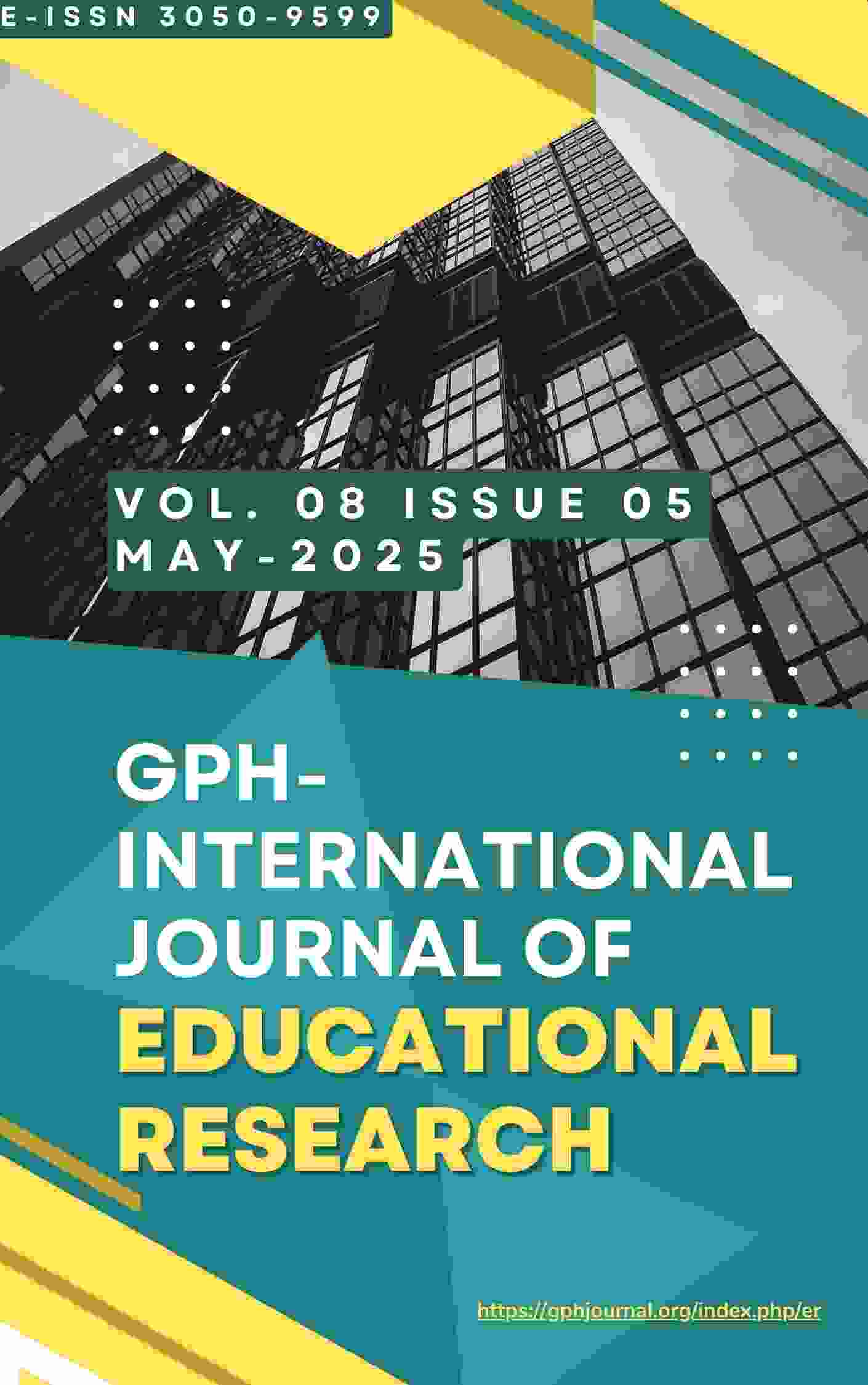Influence of Teachers’ Ability on Gifted and Talented Learners’ Performance in Primary Schools in Kimilili Sub-County, Kenya
Abstract
The objective of the study was to establish the influence of teachers’ ability on gifted and talented learners’ performance in primary schools in Kimilili Sub-County, Kenya. The research was anchored on Dabrowski’s Theory of Positive Disintegration. The study employed a descriptive survey design methodology. The Yamane formula was utilized to determine a sample size of 270 respondents from a total population of 1090 employees. The population consisted of at least four curriculum support officers, 30 head teachers, and 240 teachers who were employed by the Teachers Service Commission. The study utilized a combination of stratified sampling and basic random sampling techniques. The collection of primary data was facilitated through the utilization of questionnaires and interview schedules. The qualitative data underwent analysis using descriptive and inferential statistics, and the findings were afterwards presented through visual aids such as charts, tables, and graphs. On the other hand, the quantitative data was summarized and conveyed through a narrative format. The paper provides valuable insights for policy makers in the field of education, particularly in terms of accountability and academic achievement. Additionally, scholars may find the study to be a valuable resource for referencing in their academic endeavors. The study determined that several elements pertaining to teaching strategies had a favourable and significant effect on gifted and talented learners’ performance. The study suggests that the sub-county should consider incorporating teaching strategies abilities, such as age, gender, health, and qualifications, as these factors have been found to positively impact gifted and talented learners’ performance. The sub-county ought to adopt teaching abilities, such as class performance, academic achievement, teaching skills and teamwork school factors since they have been shown to enhance the gifted and talented learners’ performance.
Downloads
References
Alberta Learning. Teaching Students Who Are Gifted and Talented. Edmonton: Crown Rights of Alberta, 2000.
Baum, S. M., F. R. Olenchak and S.V. Owen. “Gifted Students with Attention Deficits: Fact and/or Fiction? Or, Can We See the Forest for the Trees?” Gifted Child Quarterly 42, no. 2 (1998): 92-104.
Betts, G. T. The Autonomous Learner Model for the Gifted and Talented. Greely, Colo.: Autonomous Learner Publications and Specialists, 1985.
Bouchet, N., and R. F. Falk. “The Relationship Among Giftedness, Gender, and Overexcitability.” Gifted Child Quarterly 45, no. 4 (2001): 260-67.
Colangelo, N., and K. Ogburn. “Giftedness as Multilevel Potential: A Clinical Example.” Advanced Development1(1989): 87-100Colangelo, N., & Davis, G. (1997). Handbook of gifted education (2nd ed.). New York: Allyn and Bacon.
Dabrowski, K. Positive Disintegration. Boston: Little, Brown, 1964.Francis Galton., Sir (2001) World of Sociology. 2 vols. Gale Group.
Francis Galton. (2000) Science and Its Times, 1800 - 1899. Gale Group.
Lewis Madison Terman. (1998a) American Decades. Gale Research.
Lewis Madison Terman (1998b) Encyclopedia of World Biography, 2nd ed. 17 Vols. Gale Research.
Lewis Madison Terman. (1980) Dictionary of American Biography, Supplement 6: 1956-1960. American Council of Learned Societies.
Taber, K. S. (2007). Enriching School Science for the Gifted Learner. London: Gatsby Science Enhancement Programme.
Assouline, S. and Lupkowski-Shoplik, A., (2005) Developing Math Talent: A Guide for Educating Gifted And Advanced Learners in Math (Prufrock Press).
Rogers, Karen B, Ph.D., (1991)The Relationship of Grouping Practices to the Education of the Gifted and Talented Learner, (The National Research Center on the Gifted and Talented, 1991)
Flanagan, Dawn P. ; Harrison, Patti. (2012)"Contemporary Intellectual Assessment: Theories, Tests, and Issues. Third Edition". ERIC.
Gross, Miraca (1999). Small poppies: Highly gifted children in the early years. Roeper Review.
Kranzler, John H. ; Floyd, Randy G. (2011) Assessing Intelligence in Children and Adolescents. Guilford Press.
Waddell, Deborah D. (2014) The Stanford-Binet: An Evaluation of the Technical Data Available Since the 1972 Restandardization. ERIC.
The Identification of Gifted and Talented Students | AAEGT - Australian Association for the Education of the Gifted and Talented". www.aaegt.net.au. Retrieved 2016-05-10.
Natcharian, Lisa (2015). Characteristics of Gifted Children. Raising Wizards. Raising Wizards. Retrieved May 10, 2016.
Yoon, S. Y., & Gentry, M. (2009) Racial and ethnic representation in gifted programs:
Current status of and implications for gifted Asian American students. Gifted Child Quarterly.
Warne, R. T., Anderson, B., & Johnson, A. O. (2013). The impact of race and ethnicity on the identification process for giftedness in Utah. Journal for the Education of the Gifted, 46, 487-508. doi:10.1177/0162353213506065
Camilla Persson Benbow and Julian C. Stanley (1982). Consequences in High School and College of Sex Differences in Mathematical Reasoning Ability: A Longitudinal Perspective. American Educational Research Journal, Vol. 19, No. 4, 598-622
Paul D. Slocumb and Ruby K. Payne (2000) Identifying and Nurturing the Gifted PoorPrincipal: The New Diversity May 2000, Vol. 79, No. 5 - pages 28-32
Al Baker (2013). "A System Divided series: Gifted, Talented and Separated: In One School, Students Are Divided by Gifted Label — and Race". The New York Times. Retrieved August 14, 2016.
Winner, E. (2000).The origins and ends of giftedness, American Psychologist. 55: 159–169. doi:10.1037/0003-066x.55.1.159.
Gates, J. (2010). "Children with gifts and talents: Looking beyond traditional labels". Roeper Review. 32: 200–206. doi:10.1080/02783193.2010.485308.
Jenny Anderson (2013). "Schools Ask: Gifted or Just Well-Prepared?". The New York Times. Retrieved September 27, 2016.
Gilman, Barbara Jackson (2008). Academic Advocacy for Gifted Children: A Parent's
Complete Guide. Great Potential Press.
Author(s) and co-author(s) jointly and severally represent and warrant that the Article is original with the author(s) and does not infringe any copyright or violate any other right of any third parties, and that the Article has not been published elsewhere. Author(s) agree to the terms that the Global Publication House will have the full right to remove the published article on any misconduct found in the published article.























